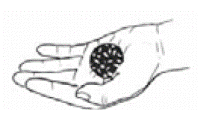A simple method to restore plant life to an eroded area is by using seed balls. Each year, collect wild seeds. Children are especially good at gathering seeds, and they will enjoy learning about plants.

Articles
How to make seed balls
A simple method to restore plant life to an eroded area is by using seed balls
2011 Available in English, French, Portuguese and Spanish

From: Trees – Footsteps 85
How to look after trees and make the most of the many benefits they bring

Gather as many different kinds of seeds as possible from plants native to the area. With these seeds and some soil, make little balls.
Mix seeds with compost or planting soil, then add clay. Add just enough water to make the mixture damp. If you add too much water, the seeds will sprout too soon. Make small balls out of this mixture. Let them dry for a few days in the sun. Just before or during the rainy season, go to the area where you want to restore plant life and toss the balls out. Building contour trenches and other barriers there first will reduce and retain surface runoff water which is needed to help the seeds sprout and grow.
The seeds will sprout when it rains. The compost provides nutrients, and the clay prevents the seeds from drying out, being eaten by mice or birds, or blowing away. After a year the new plants will make their own seeds, and before long many new plants will grow. Soil will build up around the plants, preventing erosion. Soon, other kinds of plants will appear. If it is not disturbed, after many years the whole area will be restored.
Editor’s note: This method is good for restoring plant life, but it is not suitable for reforestation. Trees often need more care and time to grow.
Text adapted from A Community Guide to Environmental Health with thanks to the publishers, Hesperian, for permission.

Similarly Tagged Content
Share this resource
If you found this resource useful, please share it with others so they can benefit too.

Subscribe to Footsteps magazine
A free digital and print magazine for community development workers. Covering a diverse range of topics, it is published three times a year.
Sign up now - Subscribe to Footsteps magazine





